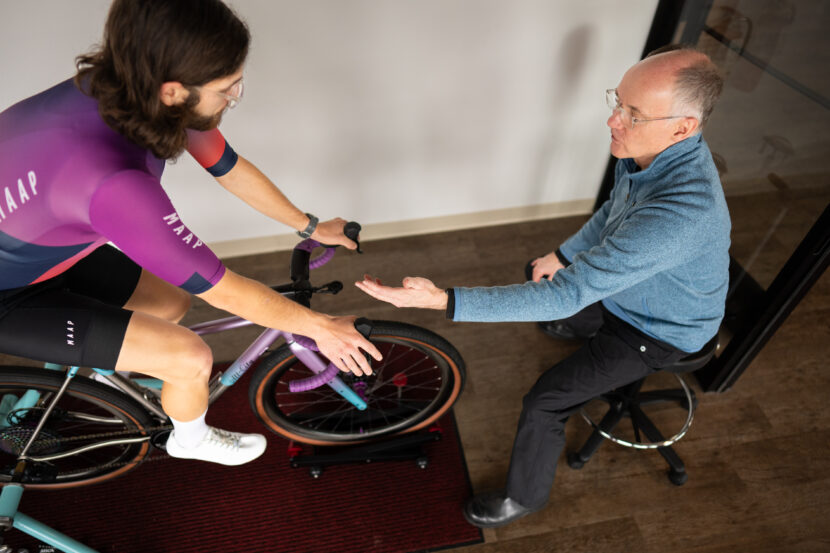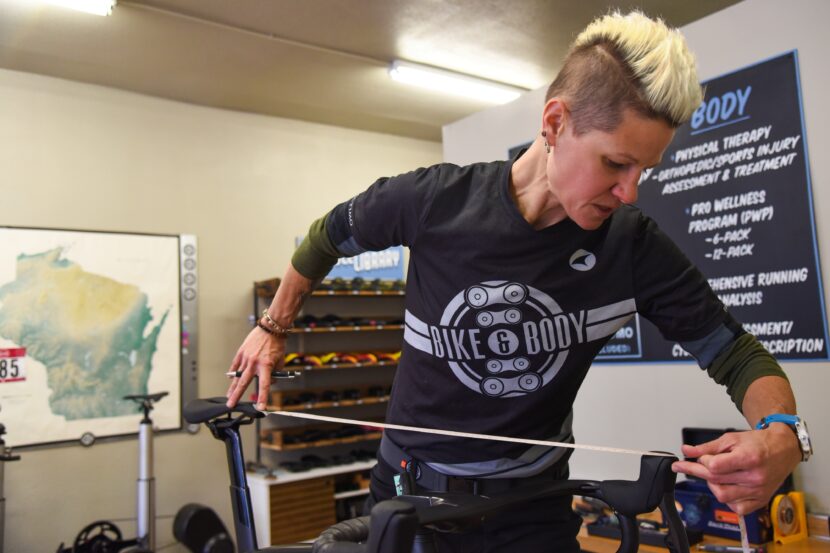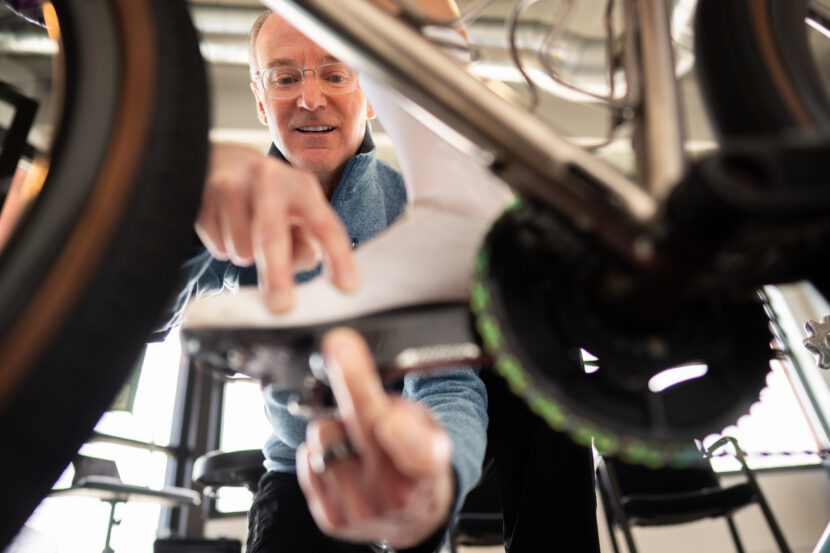
A Better Fit, A Better Ride
Do you experience pain or discomfort during or after rides? Are you looking to improve your performance and increase your efficiency? Have your cycling goals or fitness levels changed? Thinking about a new seat or whole new ride? It’s time to get a bike fit!
We looked to two experienced Wisconsin-based bike fitters, Deb Slota and Craig Watson, to walk us through the process of fitting a bike to a cyclist’s body. Deb Slota, owner of Bike & Body in Bay View, holds a Doctorate in Physical Therapy and is BikePT Gold, SICI and Cyclologic Level 2 certified. She has worked in Orthopedic and Sports PT since 2006 and has been fitting since 2012, performing over 200 fits per year for all levels/disciplines of riders. Craig Watson of Bikes Bikes Bikes in Madison is a pioneer in bike fitting and has fit over 6000 riders since 2001 and has performed over 14,000 hours of scheduled bike fitting sessions. He has also trained dozens of other fitters around the United States.
Choosing a Bike Fitter
Think through your cycling and fitness goals and any pain or other issues you are experiencing. After you’ve established what you’re looking to get out of the fit and what your bike-related goals are, choosing the right fitter will be based upon several factors. Deb and Craig both agree that years of experience and number of fits performed annually are at the top of the list of what to look for in a qualified fitter. It’s also good to know what formal training the fitter has completed as well as how much experience they have working with someone like you.
It’s important to note that independent bike fitters like Deb and Craig are not employees of a bike shop and don’t have an incentive to sell or replace parts during fit sessions. If new parts are required to improve the fit, some fitters will be restricted to the brands their store sells. Independent fitters often have access to a broader selection of parts selections and will present those options to you without bias. Lastly, keep in mind that if injury or dysfunction are a problem, a typical bike fitter will likely not be able to address your issues fully – this rider may benefit from a clinical bike fit.

What is a Clinical Bike Fit?
Only a few bike fitters are qualified to treat injuries. Bike fitters who are not medically-trained clinicians do not (and should not) diagnose or treat injuries. A clinical bike fitter is a licensed health professional who will offer a more in-depth body assessment and has advanced training in postural and biomechanical analysis. They are also able to prescribe exercises to address deficits related to your injury and make suggestions for future treatment. If you have legitimate pain, numbness or dysfunction when cycling, it’s ideal to seek out a clinical bike fitter who is oftentimes a physiotherapist (PT). If you don’t have access to one, make sure you visit a medical professional for evaluation of your injury in addition to getting a bike fit.
What to Expect During Your Bike Fit
Most bike fitters will tend to agree on a few concepts. They will ensure that you’re on the right bike, will adjust the bike to fit your body properly and, if necessary, will recommend any components that need to be replaced to optimize your position .
To begin, they will ask you questions about your lifestyle including occupation, general fitness and flexibility routines, and other activities you’re involved in. You will discuss your riding experience and training, as well as future cycling-related goals. For example, what is your top priority – comfort, speed or endurance? They will also ask about any past/present injuries or pain points. (At this point, a clinical fitter like Deb may suggest a more in-depth body analysis or diagnostic assessment).
The fit session will either take place on your own bike or on a stationary size cycle. The fitter will focus on the three points of contact – the pedals, the saddle and the handlebars. They will begin with the foot-pedal interface, which includes the shoes, the cleat position (if applicable) and the pedals. They will review the mechanics at the foot-pedal interface, looking for excessive “heel-in” or “heel-out” positioning of the foot, overpronation in the shoe, and will take note of the ankle angle throughout the pedal stroke and general foot stability on the pedal. If you’re using clipless pedals (cleats on shoes), they’ll ensure that you’re using the appropriate pedal and cleat with a float, tension and surface area that’s appropriate for your body and riding style. The fitter may suggest a shim, wedge or a cycling specific insole to improve your alignment throughout the pedal stroke and if you’re using a flat pedal, the shoes may need to have a stiffer sole.

Both Deb and Craig say they meet several cyclists a year who are suffering due to worn out cleats and/or shoes. Keep in mind that cleats, pedals and shoes wear out over time and can potentially lead to overuse injuries or even inability to clip in or out of the pedal. If this is the case, the fitter will recommend replacing those worn out parts.
Next the fitter will work to find an optimal saddle position by adjusting the saddle height, setback and tilt as appropriate. Oftentimes small changes to the saddle position can make a big difference in comfort, efficiency and power. Sometimes it may be necessary to experiment with different sizes and types of saddles. Deb offers a saddle library for riders to borrow and try different saddles before committing, saving riders time and money. Craig has a large selection of saddles for riders to try during their bike fit.
Saddle discomfort can stem from an improper position/setup, excessive wear/breakage or poor saddle choice. Be patient and don’t give up. Good bike fitters can help you find the right saddle to help you ride further with improved comfort.
Finally, the fitter moves up to the handlebars. Issues like hand numbness and neck/shoulder aggravation can indicate that the body is not connecting to the handlebars correctly. The fitter will review the stem length and angle as well as the reach, height, width and shape of the handlebars. With so many types of handlebars on the market, it may be appropriate to test out a different handlebar style to explore how it affects the rider’s on-bike issues or improves performance. Brake hoods or bar grips and shifters will be adjusted to achieve an ergonomic and safe position. The end goal is to achieve an appropriate reach to the bars with a neutral spine position. Oftentimes the fitter will provide tips to correct posture and trunk position, including cueing to activate the core muscles, unlock the elbows and lighten the grip on the handlebars.

After Your Bike Fit
If you’re working with a Physical Therapist, they may prescribe stretches or exercises. One tip that Deb frequently offers to her clients involves hip hinging. To perform a proper hip hinge, take a long flat item like a dowel and hold it against your spine. The dowel should touch your head, mid back, and the top of your pelvis. When you fold at the hips, it should continue to touch these three points – this ensures that you’re keeping a “neutral spine” and should translate to better on-bike posture. She also suggests working on general mobility and flexibility as well as core and gluteal strength.
Craig and Deb both stressed that small adjustments can go a long way to improve a cyclist’s comfort, allowing them to go further and faster, with less risk for injury. But sometimes even the best bike fit can’t fix the fact that you might just be on the wrong bike.
Lastly, it’s important to remember that “one bike fit is never a bike fit for life” – it is recommended that you update your fit at least every two years. A follow up fit should happen sooner if your fitness level has changed, you’ve sustained an injury or had a surgery, made an equipment change or are working towards a new goal.
This article was first featured in the Bike Fed’s 2025 Ride Guide magazine.